by Walter Graff
Note: Computer monitors come in all sorts of flavors. Your monitor may not see colors properly and may have gamma adjustments that do not take advantage of a TV picture properly. Here is a link to make sure your monitor is in the ballpark.
Many of my articles are black background with white type. This is deliberate. To appreciate photos on a computer screen it is better to have them surrounded by black than white. It makes things a bit more difficult to read but pictures are just as important as words here so I have to find a happy medium.
I have been able to test out all four of the new breed of prosumer HD cameras at one time or another over time. I am referring to the Sony FX1, Canon H1, Panasonic HVX200 and the JVC HD100. When I say 'test' I mean being able to set up each camera so it represents colors and pictures accurately based on industry standard charts then taking each camera out in the field and record images, and then editing those images and viewing the results. In two cases (with the HD100 and the FX1) I actually had paying jobs where I used the cameras or edited footage for a television program from them. And when I was done visiting with each camera, I was able to draw a conclusion not dissimilar to what I said about their standard definition DV counterparts; all perform equally as well with none being incredibly better or worse than any other. And as much as I saw this with my own two eyes, I still keep reading stories about how much better one is over another, or how one format lacked quality over some other format.
In general I find it difficult to read an article reviewing a camera that covers the bases well. Most people are trying to make comparisons to find "better" and not looking at each camera for it's own merits. And many articles are edited 1500 word files which tell you not much more than the brochure the camera comes with. As a result, I find many of the 'review' articles I read tough to swallow. They never go deep enough. Some simply cater to the magazines advertisers who happen to be the same people that make the camera they are 'reviewing'. And still others proliferate amateur 'filmmaker' web sites, printing what are clear biases towards one manufactures or another.
There are always differences in how cameras perform but for the most part I have yet to find two cameras in the same price range that can not perform comparatively well. Yet many of these 'tests' I read in publications and on the web are always some sort of comparison article that seem to shout major differences with no proof or substance as to why or concern about standards and methods of testing. Of course no two manufactures cameras in the same price range look exactly alike, but I find the differences are more subjective than objective. And I also find that there are a handful of people out there who supposedly give unbiased personal comparisons which in reality must be deliberate mishandling of cameras in what I can only guess is to intentionally make some cameras look worse when compared to others.
I decided that I needed to see if what I read about many of these prosumer cameras is really true. And the only way to do that is to perform tests for myself. They need to be as objective as possible and they needed to show a variety of elements and situations. They need to concentrate less on comparisons and more on attempting to make any one camera look as good as possible. The next question was what kind of test would I perform? I could test all four cameras, but frankly, that would takes weeks of work to accomplish. Anyone that tells you they are doing a multiple camera test and does not take at least 10 hours of shooting in various conditions from charts to real-world situations (outside of a test chart) are not doing a fair and balanced reporting of cameras as I see it. Most simply show some sort of chart and conclude from that what camera is 'better'. Aiming a few cameras at a chart tells you a small part of what a camera can do. It's like judging the quality of a singer by letting them sing one or two notes.
I decided I would test two cameras. And the result is that is has taken me seven days of shooting and editing not including the three days it took to scribble down this article and even then I can only draw limited conclusions. Forgive some grammatical and syntax errors. I'm just too tired right now to go back and re-read this 32 page article and my wife (a classicist) is too busy for me to bother her to proof it.
THE CAMERAS AND THE METHOD
I picked my favorite of the four cameras based on past use as my first choice. The JVC HD100 edged out others as my favorite. Ergonomically it was identical in style to all the professional video cameras I have used over the years which helped make it my favorite. It was so much like any professional camera that I could pick up the HD100 in a dark room and know where all the controls that I needed to use the camera were located including power switch, lens adjustments, audio adjustments, and menu controls. And from a perspective of picture I found the JVC to be the most pleasing overall to my eye. Yes, like others who have done tests, I found the Canon H1 made the sharpest picture of them all, but sharper is not always better. And ergonomically, if you have held a Canon XL2, then you have held a camera that is identical in feel as the H1. Needless to say I am not a big fan of the design (especially the lens) although it makes a great picture. I think if I had to describe the difference between the H1 and the HD100 out of the box (the two top contenders for someone like me) I'd say if you were shooting a TV program, the H1 is the better choice for the overall "video-style" picture quality, but if you were shooting something more dramatic or film style, the JVC makes a more pleasing picture. But the H1 can make a wonderful cinematic picture too with the right adjustments. Both the H1 and HD100 are great in that you can use lenses other than supplied. Those that do will tell you the difference in picture quality with a good quality lens is something you must see to believe. Hey, for $6k do you really think the lens they supply with this new crop of camera would be great? They're not great, but they do a job worthy of a $6k camera. If you want as much camera as a camera can give, then you need a quality lens. That's not the say that the HVX200 and the FX1 are bad cameras. They were not. Both also performed well for me. In fact the Sony FX1 was very much in line with all the Sony style cameras; reliable, easy to use, easy to handle. And the HVX200 was very much like the DVX100 in design, albeit 'fatter' with more controls all over the body of the camera. But picture wise, both the H1 and the HD100 made what appeared in my eyes to be a more robust picture. I should give the HVX200 credit for it uses an SD chip using pixel shift technology to make a high def picture. It's remarkable that it accomplishes this so well and competes well with the other three entries.
For my second camera I picked the Panasonic HVX200 since it is the next generation to the DVX100, a favorite of mine, and because it is one of the most talked about cameras on the market. There are so many ad hoc comments made in regards to this camera and it's 'ability' that I wanted to see just how well it performed. And because this camera uses a DVCPROHD format, JVC's 6GOP progressive HDV is a perfect choice for comparison. My belief is that there is less error with the shorter GOP than the longer GOPs used by the Sony FX1 and the Canon varieties. That is why I find it tough to clump all the HDV cameras together as a format. The three HDV cameras all use a variation of GOP, so they are not all 'just' HDV cameras. All have particular strengths and weaknesses and workflow's. BUt in the end, once again they all perform equally well.
I will not be testing 24p. It will serve no purpose here as it affects temporal resolution more than spatial (I'll discuss that in a moment) so for the purpose of showing you mostly stills, it will not do much of anything to affect the demonstration. I will not be discussing any variable frame rates because they also serve no purpose for this demo. Variable frame rate is a feature that has limited applications and I can create very similar effects both with the shutter controls on the HD100 and in post if I needed to. I will be shooting the HVX200 on 720p mode as I find it does not offer much more at 1080i than it does at 720p. In fact it's 1080i looks to me very much like the HD100's 720p in quality to my eye. This is because the HVX has a 960x540 chip-native resolution using H & V pixel-shift and upsample to a 1080-line frame buffer, from which all output formats are derived. That means it is not really a 1080i camera, even though it says it can record 1080i. And the reality is they are two different kinds of recording formats and really not comparable by simply looking at two pictures. One must take into account methods of playback and how the screen you watch them on creates the picture and what size that screen is. Many people believe that since 1080 is a larger number than 720 it must mean better. It does not work as simple as that. Since I am reducing both frames to 750 pixels in width for this web page, I will not gain anything with a larger 1080i frame. To understand more about the differences in 1080i and 720p read this . And to understand how limitations in how you see and what a display can show read this.
THE BIASES
Any test such as this has some understandable built in biases. One being that you the reader do not have the same high quality monitor I have for viewing and are not looking at the pictures with me live. So any photos you see represented in this article may not appear exactly as it should as there are differences in the quality of your monitors ability at seeing color and luminance and reproducing it correctly. I have reduced the viewing size of the stills to something a screen can handle. This will not affect the overall outcome to the point that you will not see what you need to see. You will! Also note: video is a presentation where temporal resolution becomes an important factor over spatial resolution. So that we are all clear as to the definitions, spatial resolution describes how much detail in a photographic image is visible to the human eye. High-resolution images are sharp, and many small details can be seen, but even the best pictures have a limit to their resolution. If you wear glasses, you can experience the effect of reduced resolution simply by taking them off. Without glasses, the view gets fuzzier and small details blend together, don't they? The ability to "resolve," or separate, small details is one way of describing what we call spatial resolution. Below is a demonstration of spatial resolution.
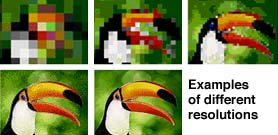
If film and television were mediums where individual pictures mattered most, we'd have to present incredibly high resolutions in each individual picture that we flashed in front of you and show them to you one at a time. Luckily because of temporal resolution and the eyes ability at filling in what is not necessarily in the picture we don't have to start off with the greatest of pictures in order to end up with a television picture that will appear pleasing.
And then it's all about how the device displaying the picture achieves this. When an image moves rapidly, a 720p HDTV display will provide more picture information than a 1080i HDTV display because progressive scan produces twice as many frames in the same period of time as 1080i. It's one of the reasons why a Panasonic Varicam with a one-million element CCD sensor makes a picture that is indistinguishable than a Sony F-900 with a 2 million pixel CCD sensor. One might think 2 million is twice as much as one million. The Sony camera makes 'better' still pictures (spatial) but the Panasonic makes up for it with how the individual images are flashed before your eyes. There are many tricks inherent in a television picture that mimics the way the eye sees and in doing so give something up that will not hurt the perceived quality of a picture. Take color for example. We know that one can throw away quite a bit of color information and a viewer will not see this missing information. It's why you see sampling numbers such as 4:2:2, etc. We don't need full color to see what appears to be full color representation on a TV screen. Already the best of television pictures samples colors half of luminance and no one notices.
Looking at still pictures instead of what is supposed to be motion is going to show you flaws that your eye ignores when the photos flash on a screen. I saw a perfect example of this last night while watching a DVD. It is one of my favorite programs of all time called 'Naked City'. The program was shot mostly by the great cinematographer Laszlo Kovacs back in the early 1960's and uses beautiful black and white 35mm cinematography. Watching the program, images look crisp and lifelike. But at one point I had to 'pause' the program in order to answer the phone only to notice the grain inherent in the program suddenly was very clear. It was grain I never noticed watching the video in motion, but once the picture was stilled, it looked like a sandstorm. Thankfully I don't watch this program by looking at individual photos or I might not think so much of 35mm cinematography. The point is that still frames might skew elements of a picture somewhat, especially in the area of noise and artifacting which are often masked by motion in a picture. We can judge many elements of a video picture from a still, but not all of them.
My DVD player also has another feature, one I find useless. It allows me to zoom in on a picture. Doing so lets me also see the grain and actual softness of the film print that normal viewing does not. What purpose it serves is not clear to me. I mention this for a reason.
Take a look at this photo:

Do you have any idea what it is? It certainly has a lot of imperfections. It's a nose but what is with the green blotches of skin? And the cracks in the skin? I guess there would not be much value to such a picture. Now, scroll down to see the entire picture:

It's the Mona Lisa! The point of showing you this is because I notice a few people running around the web zooming in on everything they can find as if they just got their first microscope with the idea that it tells you what's really going on. Even with the Mona Lisa, we've gotten so bored looking at if for what it is that some have found new ways to look at it. One group of scientists put this painting under a CAT scan and revealed that her face was actually drawn 14 times to get the final print we know today (layers of paint that was wiped away during the actual drawing or painted over by the painter). And still another group of scientists analyzed her smile and determined that her dominant emotion, at 82.67 percent, is happiness, but she has lesser feelings of disgust (9.17 percent) and fear (5.81 percent), and a tiny amount of anger (2.19 percent). If Nat King Cole were alive I wonder if he'd have a new version of his famous song talking not about her beauty, but the cracks in her face and the poor discoloration? I can see it now, Nat King Cole Takes a Close Look At The Mona Lisa. I think I'd rather look at the Mona Lisa the way it was meant to be. TRIVIA: I bet you did not know that Lisa Gherardini (Mona Lisa), wife of Francesco del Giocondo, has a veil on. When asked, 1000 people all said she did not. Take a good look! It's a delicate dark veil. Guess the microscope people would have discovered that if they zoomed in! :)
We could spend the day looking at all sorts of things involved in what makes up a video picture but after all is said and done, I feel it important to see it in the light that we are used to watching it. So for all these guys who spend countless hours zooming in looking for artifacting that you can't see with normal viewing, or mysterious martians, I say you will not see me do that because frankly unless there is something wrong with a picture, there is no need to. If I zoom in, it is to point out something in particular and not to say "look at this dot, it must mean the picture is not so good". If a picture makes something that is appealing to me on a monitor the way it should be viewed, then I don't need to zoom into to it 1200 times magnification to see what lies underneath. I could do that to 65mm film too and then you wouldn't think as much as it as you do. I know what I will find and most of the time it has little to do with me seeing a film or video and appreciating it.
And finally, I want to discuss what I am looking for here. I am not one of those guys who spends hours looking at every kind of test chart in the world hoping to find some flaw or magical resolution number. We have seen all sorts of variations of that on the web and in articles, some more biased than others, but all just as confusing as the fortune in the cookie after my Chinese meal last night. If these tests I see were performed by qualified engineers under proper conditions, they would show similar results as mine, but many don't. That tells me that as objective testing goes, they are useless since no one can seem to agree what they should say. And give an engineer a camera and he looks at stuff that a director of photography might not find as important. It's a balance for me between technical and real-world use. I will look at a few charts but for the purpose of setting up cameras to see colors properly, but I'll be looking more for similarities, not differences, and to make sure the cameras are seeing the world correctly, not to tear them apart because they can't see the subtlest change in a color, one you can't see with your eye either. No camera made today sees better than your eye and I doubt any camera will. My goal here is to see if I can make one camera stand out over another and if not, can I make them look similar. To me there is so much more to say about making two cameras look similar than dissimilar. I can make any two cameras look different, but can I make them look the same? If not, then and only then will I find a deficiency in a camera, not because both were white balanced without a common reference and someone thinks this means one looks "better"."Better" is not only a misleading term in testing here, but worng. If you are looking for hte "better" camera, you iwll not find that in this article. You will find two cameras that both perfrom well. I avoid teh term because it can not be used in subjective viewing.
And because I know from experience that all of these cameras look more a like than dissimilar, why would I care to prove that I can make any look like two different cameras? My idea of testing is to get the most out of a camera, not the least. It's very easy to make cameras look different, but very hard to make them match.
Some folks think that once you turn on these cameras, they should look like 35mm film. I am not attempting to make the most organic looking film-like picture here. I am shooting 30fps with an attempt to see how a video camera performs in the area of color reproduction, dynamic range, and overall ability at recording format. If it performs well as a video camera, it can perform well as a film-like camera too once the settings are applied. I am not shooting 24p which would give one that organic film-like look with motion. As I said, a good video camera can reproduce a picture well and can be adjusted to make something look more like film, but that is not what I am trying to do here. And at that point, quality is so subjective as not to be comparable, so I will not attempt it. If you are looking for the most film-like looking shots here, you are wasting your time.
I am going to try to make the most of both cameras in question, not try to make one look worse than another and then say 'buy this camera, it's better'. I have no monetary or egotistical gain in writing this article. I am not interested in what camera you buy. I just want to know what camera would suit me best for my needs as an inexpensive HD camcorder and I'm sharing that information with you. I've picked the camera I found to perform the best from past use and set it up next to the camera that has gotten rave reviews to see what I can find.
SETTING UP THE CAMERAS
First thing to do is to look at both cameras on a test chart and monitor and make adjustments internally so they are seeing the world fairly. Most folks will simply turn a camera on out of the box and say 'look at how well it makes a picture', but anyone with any experience knows that cameras come out of a factory working, but not necessarily working to their optimum. I used an industry standard chip chart and waveform/vectorscope to make sure the cameras were seeing things well. Note: I was so into making sure the cameras were adjusted and set up properly, that I forgot to record this set-up as my fist photos to show. :(
After all was said and done, and both cameras produced an acceptable picture, it was time to look at how well things were being reproduced next to each other. So I set up a MacBeth Chart to see how the cameras produced color. (Note: I am using the cameras stock lenses. I am feeding the HVX recorded material to my Mac with FCP via the ' IMPORT-P2' function in the FCP software, and sometimes dumping P2 directly to the computer via a slot. I am using HDVxDV to import the HDV material from the HD100 via fire wire and then unwrapping the file as a 4:2:2 uncompressed Quick Time file for use in FCP. All photos here are in full quality JPEG's. If you want a particular Photoshop original or movie file, simply get the name of the jpg on this page and ask for the original or movie file.
Each photograph seen in this article was individually focused prior to recording using each cameras focus assistant to maintain integrity of the individual shots.
First, let's a look at the two cameras ability at color reproduction on a color chart.
What I was able to see from this chart comparison is that both cameras produce colors accurately. None is worse or better, just slightly different. In addition, it tells me that if I had mixed source materials from each camera I know that I could use them together on a timeline (as long as they were both set-up properly). You may notice that in some shots the black levels of the HD100 seem blacker in capture but that is something that I would be able to a just easily with a bit of color correction if necessary so that is not really a factor. These cameras are as close to producing the best pictures they can using a chart and waveform to set them up. Based on the photos above, I'd give the HVX an ever so slight advantage in the blue and green areas as they seem more saturated to the eye whereas the HD100 is red happy. But once again none of those differences, as slight as they appear, are something that could not be corrected easily in the course of an edit if one so desired.
COLOR SPACE
I hear allot of rants about the 4:2:2 color space of the HVX200 and how it is a great improvement over the 4:2:0 color space of HDV. I can say after these tests that I can not find a clear difference. Based on my testing I can safely say that the HVX200 is not steps above the HD100 in color reproduction as I see it. In a moment I will show Chroma Key tests to show how the different codecs key and what the differences are. I have noticed that 4:2:2 is really not all that noticeably different than 4:2:0 in the first place so while it might have statistical advantages, I think they are masked in many real world situations.
Next I took a look at a Gamma Density chart to understand more about color and luminance and how these cameras reproduce various elements of a picture.

Looking at the grayscale's of the Gamma Density chart, I saw nothing out of the ordinary from both cameras. I did notice that the blue, zone typeface on the HD100 appeared slightly more readable than it did on the HVX on the HD monitor screen I was watching. You may also see that here. It matters little because it is not something that clearly distinguishes the cameras. Both cameras suffered from various forms of artifacting and noise when making a still that one can see in the photo above. But on a moving screen the artifacting and noise was disguised and is not something that disturbs me. The HVX200 made a bit more noise in the blacks than the HD100, but not the levels of noise that some seem to complain about. I'll tell you more about this later.
The color portion of the Gamma Density chart offered something interesting.

As you can see the red colors with the HD100 are saturated a bit more than what the HVX produces, maybe too much. There also appears to be more artifacting noise in this still in the HD100 strip but as you will see later on in a moving sample, you can not accurately look at a still and say anything of value related to artifacting and noise without seeing how it works itself into a moving frame. Overall both produce vivid colors and offer nothing that could not be color corrected in post as you would any shot. In fact notice the black strip on the left side of the photo representing the HVX being slightly grayer. That tells me that a slight bit of lowering of the black levels in post and the color accuracy would have been even closer in the lighter hues than it is here. I choose not to correct any pictures.
GREEN SCREEN
And finally before we take these cameras in the real world where they count the most, I need to take a look at another often talked about area, green screen. The current consensus by many is that the 4:2:2 color sampling with DVC Pro HD in the HVX200 is far superior to the 4:2:0 sampling of HDV and really shows up in chromakeying. I needed an answer to that question so I set up a simple experiment using a furry bunny (fur is more difficult to key). I set him up over green screen. I have all sorts of fantastic software programs for cutting perfect keys in post but thought I would keep this experiment fair so I used the less than adequate chromakeyer that comes with Final Cut to see how well I could cut keys and demonstrate how well 4:2:2 keys over 4:2:0 color space.

I imported both cameras shots into FCP and keyed my subject over black so I would see any irregularities clearly. Below are the matted outputs.
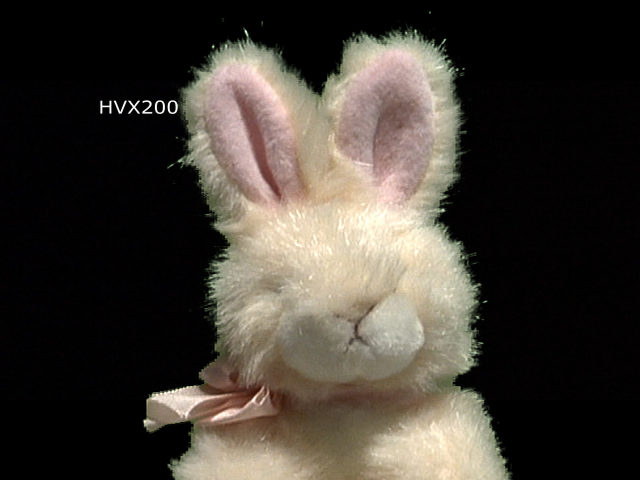
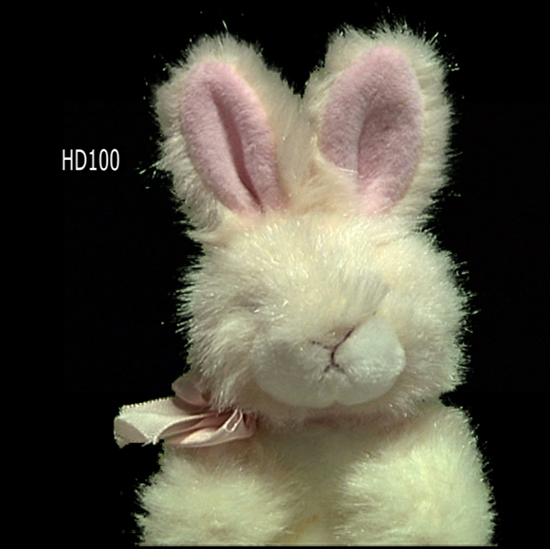
As you can see from the chroma key set-up screens below, both keys above required similar adjustments from the controls of the chromakeyer with none out of the ordinary or much different than the other. The photos above do not have any edge softening applied as of yet. I'll explain.
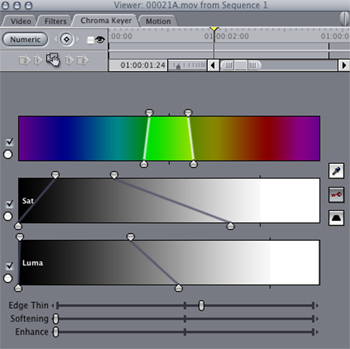
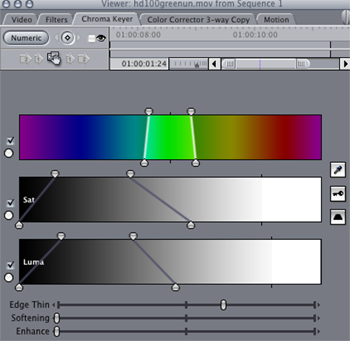
I do not have any softening applied for a reason. I wanted to demonstrate one instance where a still photo does not necessarily show an accurate representation of how video looks. Using edge softening softens whatever edges are in the green area helping to smooth out rough spots. I did not use it yet in order to show you two perfectly fine still shots confirming that both HDV and DVC Pro HD (in the HVX200) can cut keys equally well. But here is a perfect time to show you how pictures can be deceiving. Take a look at the bunny pictures above again and notice that the edges look acceptable. None keys substantially better than the other. Perhaps the keys are a bit rough, but that is because I am keying them over black which will show every single imperfection. When keyed over a normal scene such as a grassy field temporal motion and the addition of color helps cover up some of the imperfections. What happens when I show you what the real video of both shots above with no edge softening looks like? Here is a clip from the stills above. Notice the ringing around the bunny. (The first half of the video is the HVX and the second half is the HD100 distinguished with titles). Both suffer from the ringing.
Click here for video of bunny with no softening
So while the stills looked good, the same stills shown as videos demonstrate that you can not necessarily judge how well something keys from a still alone. Representing video as just a still can be misleading because as this demo shows, while the stills look acceptable in reality the video is not. What I would really have to do to the video to make it work better as video is to use some edge softening to help eliminate the jitter. But in doing that, someone might say it looks like a soft key in the still. I hope you see the point; still images tell a story but not the entire story depending on what you are trying to demonstrate. One must consider motion when comparing many things that need motion to completely comprehend. Once again the rabbit is keyed over black so it is not a perfect world as any imperfections are shown but if I keyed it over real video you would more than likely not see the imperfections. Edge softening is necessary in both shots and even so as the following clips show I had more room for improvement. You will notice a bit of ringing that I thought I got rid of. Chalk it up to FCPs lousy green screen software. This would be a better option beyond what FCP gives you.
Click here for video of the bunny with edge softening
One thing I learned here is that as an acquisition format, HDV does not seem to suffer from some of the problems I keep reading about. It seems to key well, as good as any other format I have used. Had I used Keylight or any of the more sophisticated keying software, I would have not had any problems whatsoever so as I always say, a good key is about how it's shot and what you use to cut the key. I can cut perfect DV keys with such programs so cutting higher resolution keys is just as easy. I find that some folks who complain about how something does not work well seem to have never used it or never used it correctly. What does "using it correctly" mean? It is important to understand any formats abilities and limitations and in this case HDV as an acquisition format. I would not want to edit in native HDV. I think it works perfectly fine as an acquisition format, but after that I choose to move it to a format that is easier to edit. I don't capture it as native HDV but rather up sample it to a 4:2:2 color space and keep it as a 10 bit uncompressed Quick Time file using the software HDVxDV. Tape is cheap and when used in a proper workflow, as my testing shows it rivals what others claim is a more robust format. While I wouldn't doubt a camera with a bigger CCD and more electronics behind that CCD would do a better key, all these 1/3 inch prosumer cameras are very similar in size and electronics so they are more on a level playing ground regardless of specs that might sound more robust.
I am also using nothing more than regular DV tapes with the HD100 and not the expensive HDV tapes for this demo. In general, they offer me no less quality than their expensive counterparts other than the possibility of a tape hit (I have yet to encounter it). I'd more than likely use the best I can buy when shooting something important. That means that if I ran out of tape while shooting, I could visit a local beauty aid or food store and purchased tape if I had an emergency.
The key is understanding the possibilities and using the best workflow with any format. Since FCP is native to DVCProHD, I use it for P2 work with no problems. And as the time of this article, no one has come out with a great HDV native workflow for FCP so HDVxDV software is a great capture tool for FCP. I could do it other ways using FCP, but I like this method. Bottom line: When I make sure to optimize my workflow, I get the most out of a format that might not handle the riggers of editing well by itself. Since I understand that would be a potential problem with HDV, I use it as an acquisition format only.
MOVING TO REAL-WORLD ENVIOURNMENTS
Now that we have seen both cameras and their abilities in a controlled environment, let's take them out for some real-world looks. I'll start with a sunset shot exposing for the clouds.
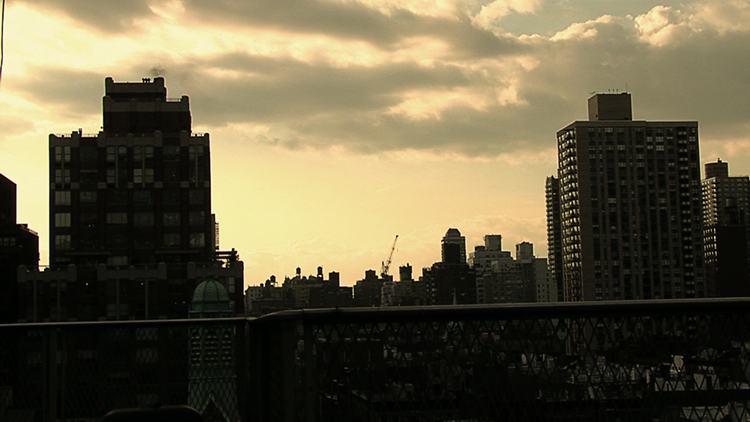
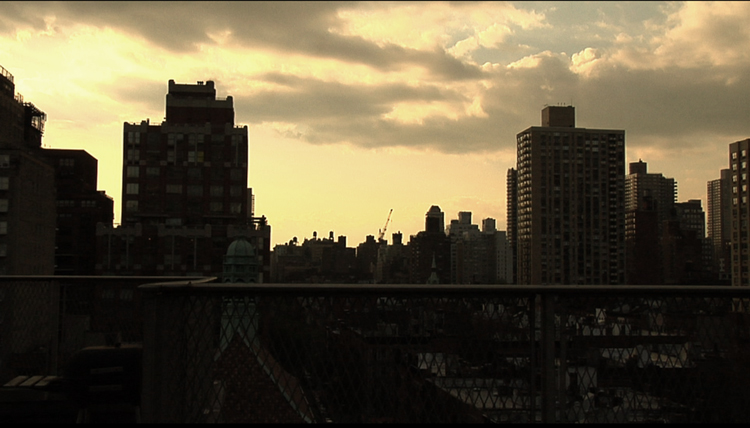
Can you tell which camera is which? I always notice that the HD100 is slightly more appealing overall look than the HVX200 on my monitor. The second photo is the HD100 and the first photo the HVX200. Other than apparent sharpness due to the more robust detail on the HD100, I can not really tell much difference in the two cameras. I deliberately white balanced warm. Both suffer from the purple fringing in the clouds so common with these 1/3 inch cameras and over exposure. But other than that, if I hadn't labeled the two shots, I probably would not know which was which as they are so similar as to be near identical. Notice the crane in the distance? With these cameras I can zoom easily into it as seen below:
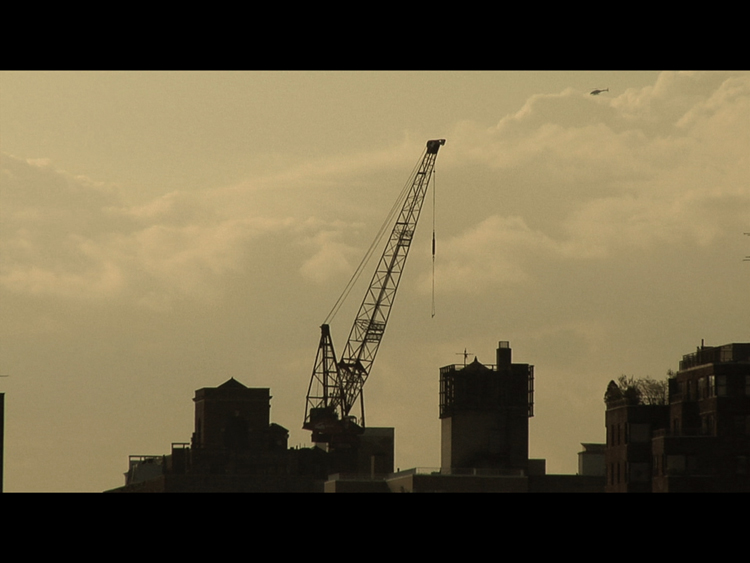 HVX200
HVX200
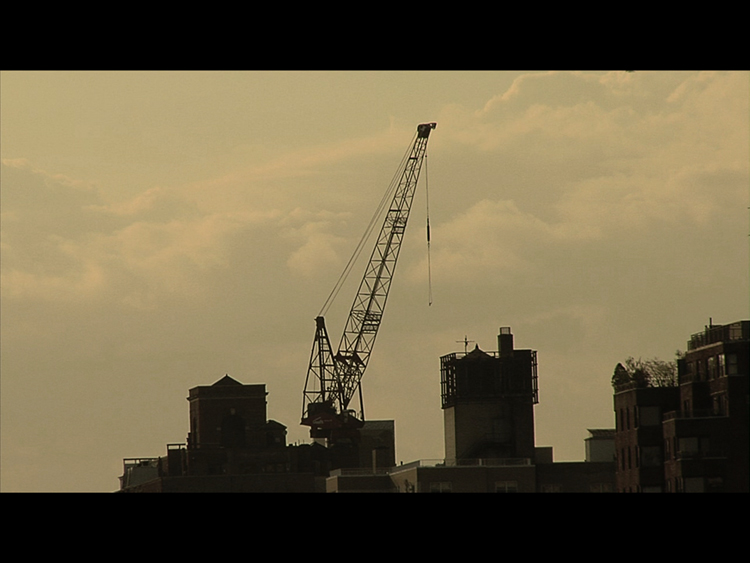 HD100
HD100
Once again the two cameras are closer in picture quality than farther apart. I do notice a slight bit more of that purple fringing I saw earlier in the wide shot of the clouds in the HD100 shot. Perhaps that is a factor of the knee circuitry in the HD100 which was raised in this camera.
HVX200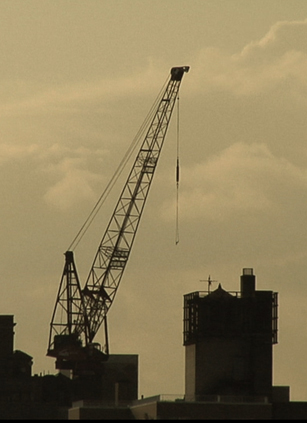
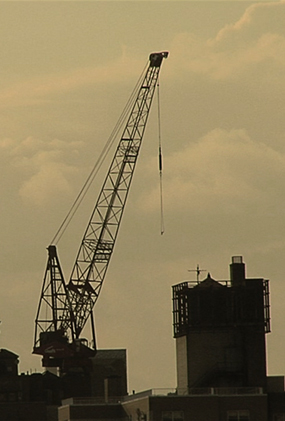 HD100
HD100
In the two shots above, the look of the lattice work of the crane and in the water tank tower to the right of the crane is slightly different than the shot on the left. And if you notice the top of the building itself has more defined definition in the HD100's shot than in the HVX200. I could adjust both cameras to see more or less detail so it matters little although the most detailed setting of the HVX is still not as far as I can get with the HD100. In fact I will show you numerous shots in this article with details both high and low so you can see the differences in perceived sharpness in the cameras for your own evaluation. I'm ignoring the blacker blacks of one picture over another because that would be easy to compensate for in post. Once again it seems like the higher resolution chips of the HD100 are about the biggest difference in the two cameras which I don't think you can appreciate here as well as I can on a live monitor designed to produce a video picture.
Behind the scenes, Panasonic used a trick called pixel shifting to make what appears to be a sharp picture but often shows its true colors when shown side by side with more accurately devised HD cameras. By "more accurately" I mean a camera that uses true HD CCDs and not pixel shifting. Pixel shifting a a nice trick that means it cost Panasonic less to develop their camera, but the results are that the camera suffers in the high def world. The HVX suffers as it is really nothing more than SD chips that use pixel shifting to create High Def. Other than that, these two cameras would be tough to differentiate in apparent sharpness and I would find it hard to say which is clearly better if any. Those differences would only show up later if you were using your footage on larger screens and mixed with other more robust HD camera footage. The bottom line in the following comparisons is the HVX suffers time and again in true resolution because the HVX uses H & V pixel-shifting for greater apparent sharpness (albeit no real improvement in limiting resolution).
Here is a shot with the detail settings of both cameras turned down to their lowest settings. On the left is the HVX at -7 and on the right the HD100 at min (-10):

NIGHT EXTERIOR
Let's explore something that has been on my mind ever since I saw an article somewhere showing clips comparing a nighttime shot of an HVX200 and a HD100. What bothered me by the shots was that the HVX looked so incredibly clear while the HD100 had horrible purple fringing around headlights of cars and more artifacting than rabbit ears on a TV. Having used the HD100 before, it did not seem normal to me. It almost looked like what happens when you take a clear lens cover and put it at a slight angle to the front of the lens creating a purplish ghost and throw some snow in. So I decided to take a camera out at night on a darkly lit street to see what I came up with with no adjustments of the cameras.
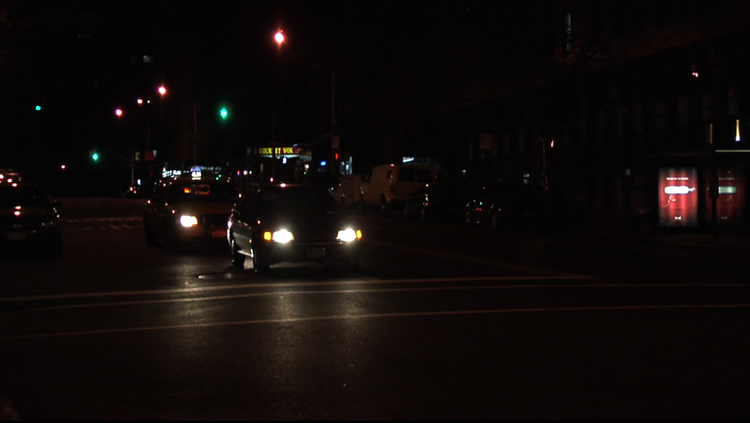
This still (above) is taken from the HVX200. I notice slight streaks in the headlights (vertical smear). The darker areas are a bit darker than my eye can see, but overall I see a good reproduction of the picture. No gain is being used and there is no noticeable grain or noise in the picture.
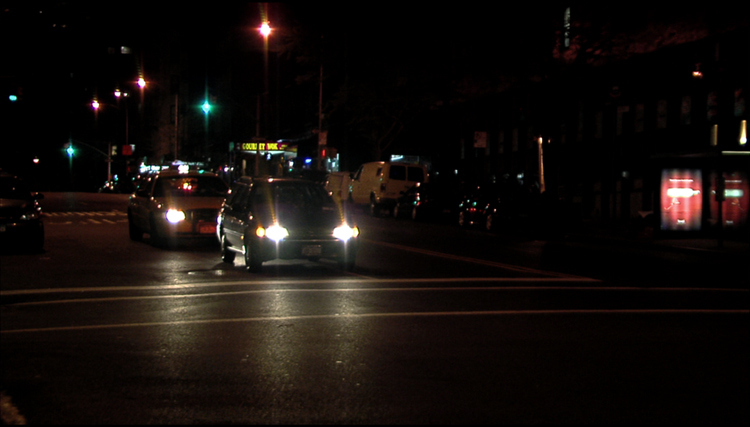
This is the frame taken from the HD100 (above). I do notice more vertical smear above and below the headlights. Both cameras do smear but it may be the slight difference in camera angles, or that the HD100 smears more than the HVX200 in this situation. While both cameras have matching zero gains, the HD100 seems to pick up a bit more light in darker areas than the HVX200 including the very faint lights from windows in the distance in the top left-center of the shots. This is probably because the iris on the HD100 is open slightly more than the HVX. Of course if I played with both on location I could have pushed either to see a bit more in the shadow areas so it should not be looked at as a judgment of inherent quality. I could have gotten a bit more with both in post if I tried too.
There is one annoying artifact that I see wherever there is yellowish light (headlights, running lights, sodium vapor) with the HD100. It's that somewhat diagonal stuttering streak of light that is sort of like yellow stuttering smear for lack of better term. Here is a close up of the area I am referring too with red boxes around the phenomenon:
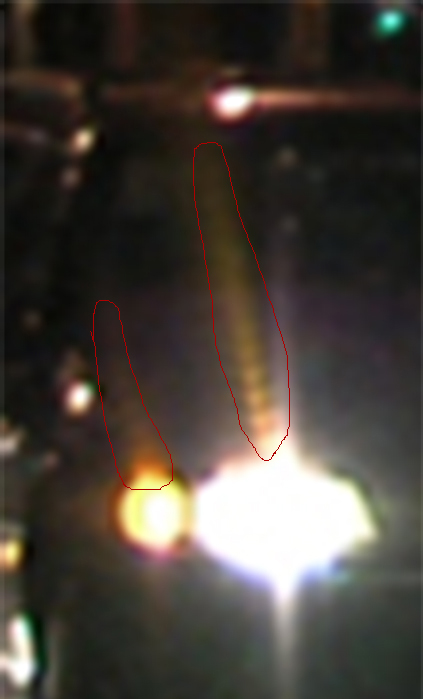
I do not know the cause but it is not pleasant. If anyone does, please tell me. The HVX200 does not do this.
Let's look at another shot:
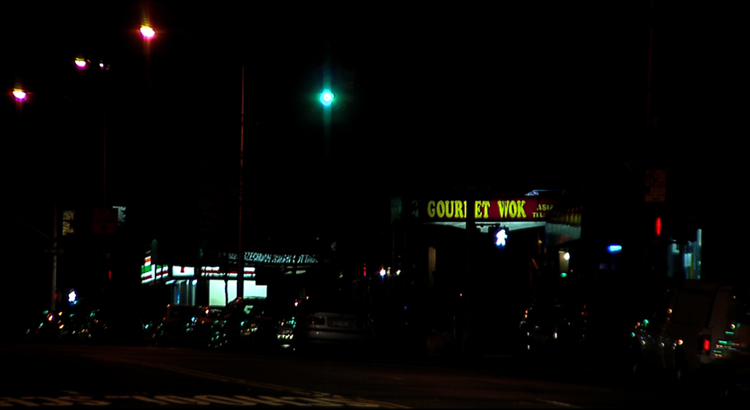
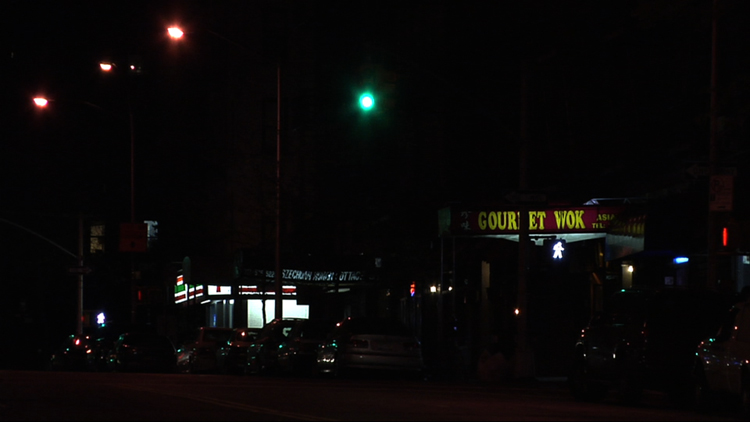
Looking at the two shots above, see if you can tell the tale-tail signs of the HD100 based on the last photo and that mysterious yellow streak? If you said the top photo (streak seen near sodium vapor lamp), you are correct. Other than that streak which only appears near yellowish point of light, both cameras produce an excellent quality picture, none better than the other in this lowest of light situations. Both handle blacks equally well. Now let's take a look at some daylight shots.
I also wanted to know how the cameras gain feature worked in this real world situation. The HVX200 offers a maximum gain of 12db in the high setting while the HD100 can go up to 18db. I tried both cameras settings to see what the results were.
An important thing to understand is that each manufacture has different standards for such things as gain based on the electronics of the camera. In other words 0 db on one manufacturers camera might not be the same setting as another manufactures. Sony and Panasonic in the form of the HDCAM and Varicam are two examples where -6db on one is not the same as - 6db on the other. And with these two cameras I see differences in gain settings too. And that means that direct comparisons are not possible. For instance 9db gain on the HD100 looks very much like 6db gain on the HVX200. So while I can not make judgment calls based on numbers I can look at issues such as how much noise the additional gain adds, or how much more vertical smear is added from gain. So let's take a look at different gain settings in both cameras.
First a series from the HVX:
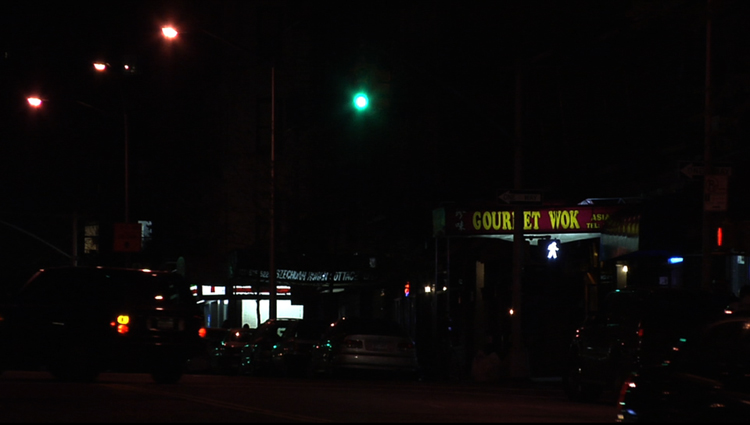 0db
0db
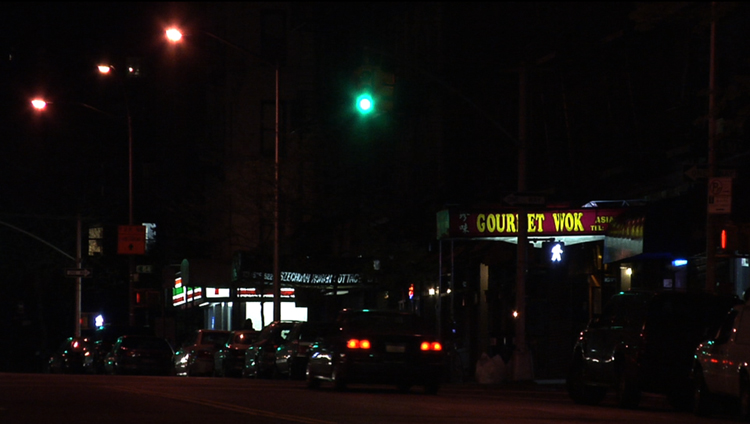 6db
6db
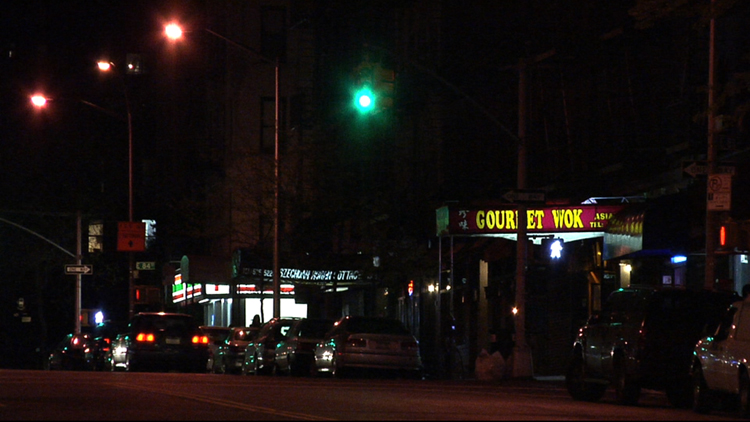 12db
12db
And now a series from the HD100:
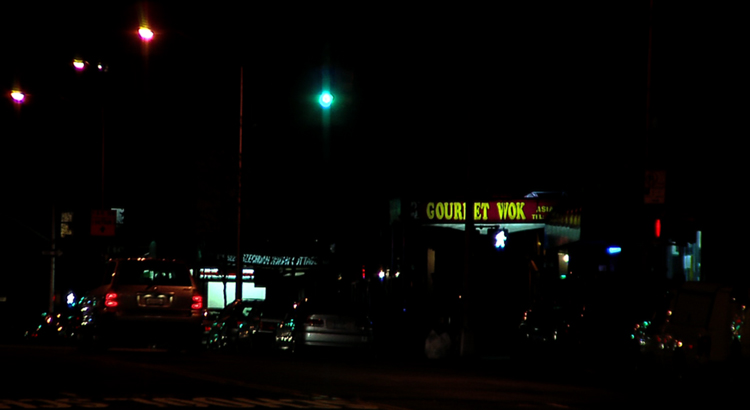 0db
0db
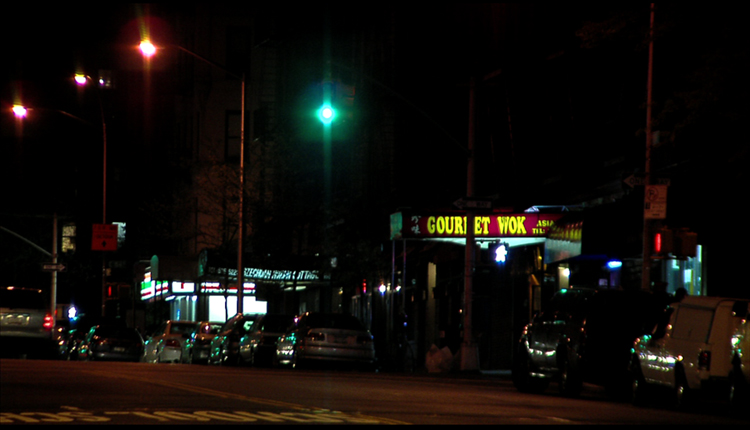 9db
9db
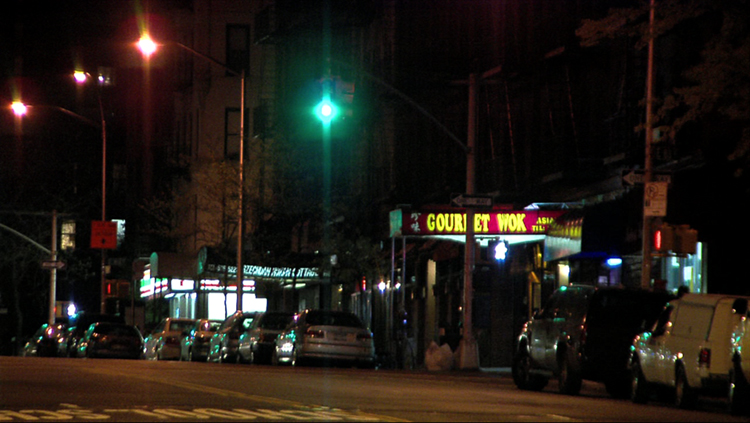 18db
18db
With gains applied, both cameras raised noise levels as expected. I thought the 12db setting in the HVX200 was more equal to the 9db setting of the HD100 when looking as similarities in noise and exposure. Overall the HVX200 was noisier at both zero db and at 12db gain. HDV has an interesting effect on blacks as if it sees true black in a shot it makes nearly no noise in that area where the HVX noise falls more throughout the picture in both light and dark areas. I tested this by shooting a wall and covering half the lens with my hand. The area where my hand covered the lens had absolutely no measurable noise. It was as if the black area was a dead part of the CCD. I took a frame to photoshop and when I adjusted the levels to see what I could get, I saw pure black with slight artifacting in one small area that does not appear on a regular picture. Overall it seemed as if I could get more exposure latitude out of the HD100 when I played around with both.
I have read quite a bit on the web about the inherent noise in the HVX200. Many owners complain that it's too noisy. I recently saw a post by a Panasonic employee who after along thread discussing the noise issues admitted the HVX200 is not the quietest of cameras. But wait? If you looked at my photos above you do not see much noise. There are two reasons. One, in the translation to stills, some of the noise becomes transparent. There is some noise in the picture as seen on a real TV, but it get's lost here. Two, there is a little something I found while shooting related to noise in the HVX200. In fact shooting a night scene with bright lights such as car headlights is part of the solution. I found that when I shot dark scenes with contrasty bright points of light or higher gray values in the darker areas, the HVX200 masked noise much better than when I shot darker scenes with little contrast. When I shot scenes with little contrast, the HVX looked like a sandstorm on Mars. Chalk it up to how the CCD and DSP in the camera communicate along with format issues. Besides contrast to help you avoid the noise, one of the worst situations I found is shooting flat surface which excentuates various types of noise in this camera. So if you can avoid a darker flat wall in an interior night scene you will be better off. In post, this noise makes color correction of darker shots with the HVX200 near impossible as the 8 bit codec adds a lot of noise if you try to turn anything up. I also noticed that the CineLike-D gamma in the camera is the noisiest of all gamma settings so one has to crush blacks in certain shots to avoid macroblocking from the DVCPro codec and the noise from the chips but you eventually loose all dark areas so it's a trade-off. But once again what can you expect for $6k? Worst off is the monitoring on both cameras in that you can not see this noise until later unless you are using a quality external monitor. Even the noise in the shot below does not show on the cameras monitor if you look for it.
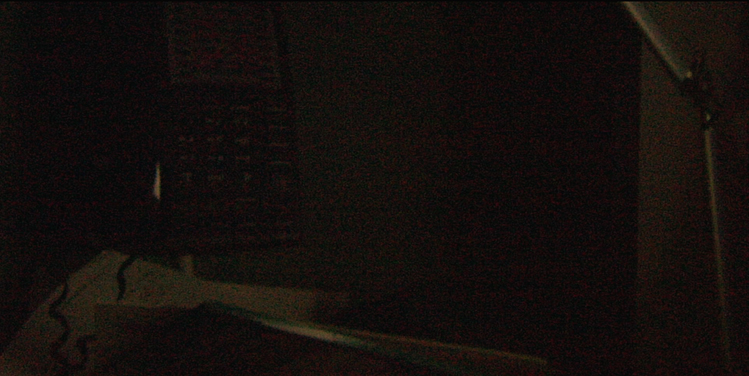 HVX200
HVX200
Depending on what type of shot you are shooting, the HVX200 can be your friend or your worst enemy. The solution is lighting darker scenes differently, with more light actually.
And I wanted to say a word about sensitivity. I see the sensitivity police running around the internet asking the magical question of a camera that usually goes, "what's the ASA". For years video manufactures printed sensitivity specs that said something to the effect of f11 at 2000 lux. That statement in itself is like asking where you left your sunglasses only to have someone respond, somewhere on this planet. Then I saw them state sensitivity numbers as "minimum illumination 7 lux". This is another term that tells you as much as as the Happy Birthday song tells you about someone's age. Lately folks have decided incorrectly to use terms such as 320ASA, etc. A video camera does not have a skiable MTF like it's film counterpart does nor does it have an ISO or an ASA which is a film term used for still photography, not for motion picture photography, and definitely not for video photography. If you use it you show your ignorance, not your savviness. A video camera can have an indoor reading with a light meter that is closer to a film of 320ISO and yet that sensitivity is closer to a films 640 ISO outside. Light does not fall linearly on a CCD as you open and close a lens, especially wide open where microchips help you least even though they are supposed to help you the most. I don't use those film terms for video because they are not a video standard. A video camera can have an exposure index at a particular range of a lens opening but it will not remain that way throughout the range of the iris. I am not interested in a camera that is rated at 1 lux. That number in itself means little to me. The difference between a camera that is rated at 3 lux and another rated at 1 lux tells me one will see a dark room as dark, and the other a dark room as dark too. 100% of what I shoot is with light. Maybe not the best light all the time but I have yet to use a camera ($100k or $100) that can not make a picture in a room of natural light that is not or can not be made to look appealing. I know from experience that a chip with larger openings (less pixels) sees better than a chip packed with more. So I would guess the HVX on paper should see light easier. But then again you have other factors like noise etc added to the equation. So I am not going to see which camera is faster or which can see the Aurora Borealis on a cloudy night. For folks that are obsessed with such numbers and incorrect terminology, you will have to find some other place to get your fix. I don't shoot in coal mines with cameras or on dark beaches looking for spirits.
DAYLIGHT
I spent some time shooting various shots around NY. Let's take a look at a few.
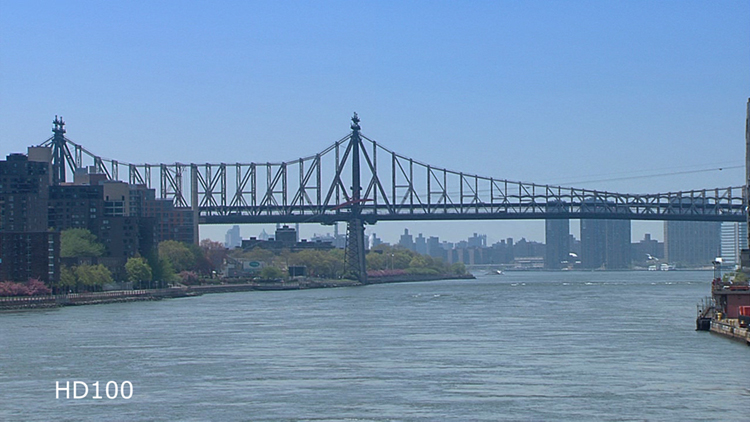
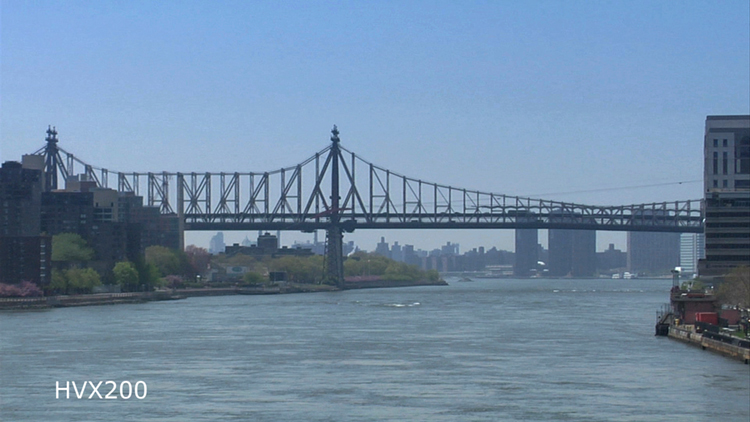
Both shots above are taken looking down the East River at the 59th Street Bridge. I added a graduated blue filter to both to give the sky a bit of color. Both shots are pleasing. With a bit of color correction I could have made them look exactly alike. None stands out in my mind as clearly and remarkably different than each other.
Here is another shot of The Circle Line:
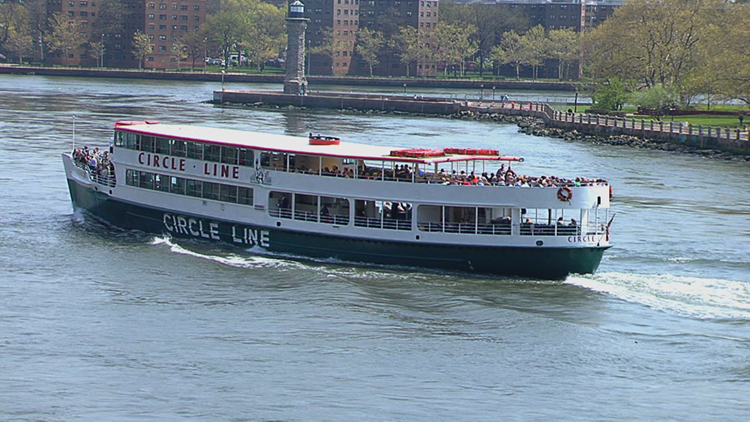 HD100
HD100
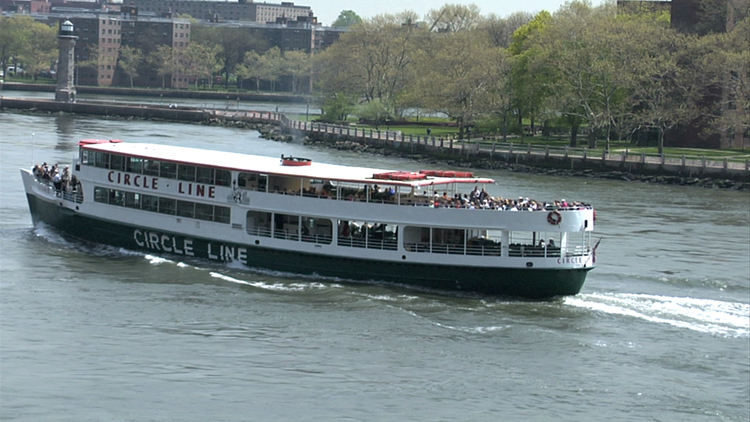 HVX200
HVX200
The top photo is the HD100. As you can see if you look closely, I accidentally overexposed the shot a bit with the HD100, but the HD100 held the shot well. And nothing wrong with the HDV200 shot. In my tests of overexpose I did another day, both handled overexposure as good as I would expect and more like a standard definition DV camera than anything else. About the only difference I noticed on the monitor was in the fine detail such as the trees on the background which look a bit sharper on the HD100. Once again I can push detail levels or reduce them. That is about taste. One reason why there is a bit of a discrepancy in detail here is that on my monitor the HVX200 looked good at a particular setting while the HD100 had it's own sweet spot and seeing them next to each other here is not necessarily fair because one really should look at a picture alone for what it is by itself. Any comparison is going to create less objective results. And as I said, I could crank up the detail on the HVX200 to nearly equal the HD100 but this is not about who is sharper, but rather about what looks best for a particular camera. Like with color, they can have the same or near the same apparent sharpness adjusted with detail. Some people have asked me if I crushed the detail on one camera and increased it for the other. The answer is no. Detail will not give you resolution, only create a false sense of sharpness that can soon turn a picture into something ugly. I found detail settings that don't overexagerate the pictures on both camera but don't cripple them either. They are not identical because as I said, I am looking at each picture for what it is by itself an not trying to compare it directly to the other. But since I have to present them both here, it seems like it is a comparison of better or worse. It is not in this case. Like gain numbers, detail settings on two different cameras don't necessarily correspond. With these two cameras I have to put the detail setting on the HD100 near it's lowest to make it equal to the HVX200 at its highest. I always believe that if a manufacturer gives you a range for detail and you have to set it at one extreme to make it appealing then you are not seeing the camera the way it was designed to make a picture or the camera simply is not as good as you expect it to be. I adjusted the final settings for detail in both cameras where it looked best on a monitor. Without seeing both on a real monitor something is lost slightly in the translation here. And as an earlier shot of both cameras with detail at a minimum show, no detail is different between two cameras, but if my purpose was to match detail, I could find settings that corresponded to both cameras. But I am not attempting to match two cameras.
Just to show you a range of detail, here are some shots of the crane again with detail set to minimum and maximum. Edges get sharper, and depending on how you are watching it or where your final product is going, you may want/need more or less. Don't look at this as the end all in settings. The higher res chips of the HD100 mean that I actually have to decrease the detail setting to make it work well and look pleasing. It has a greater degree of range with detail compared to the HVX200. The HVX only lets you set detail at a minimum whereas the HD100 allows you to turn it off completely.
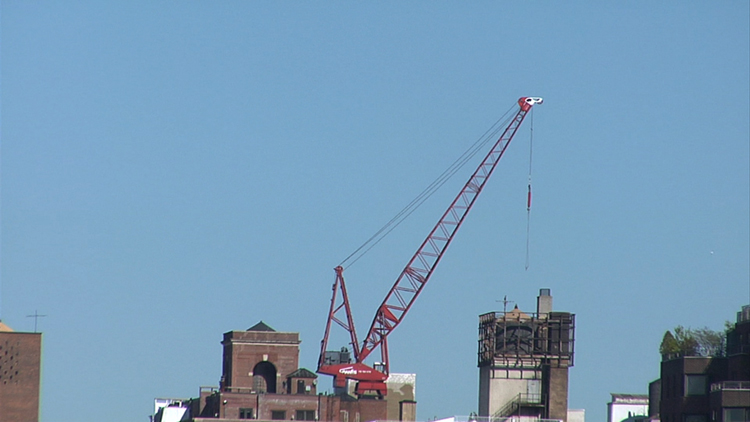 HVX720p +7 detail
HVX720p +7 detail
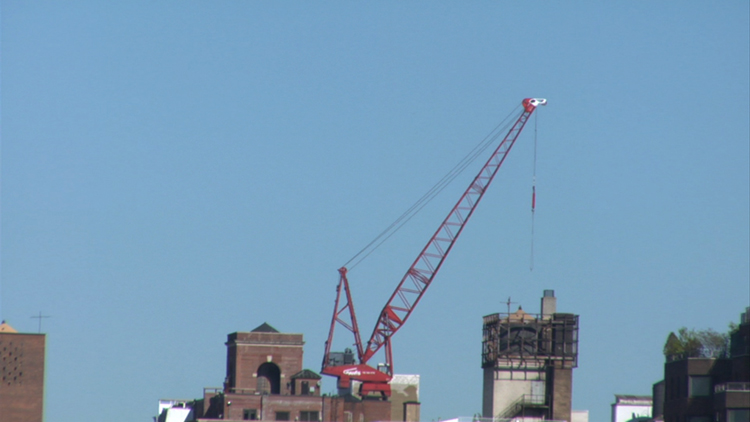 HVX720p-7 detail
HVX720p-7 detail
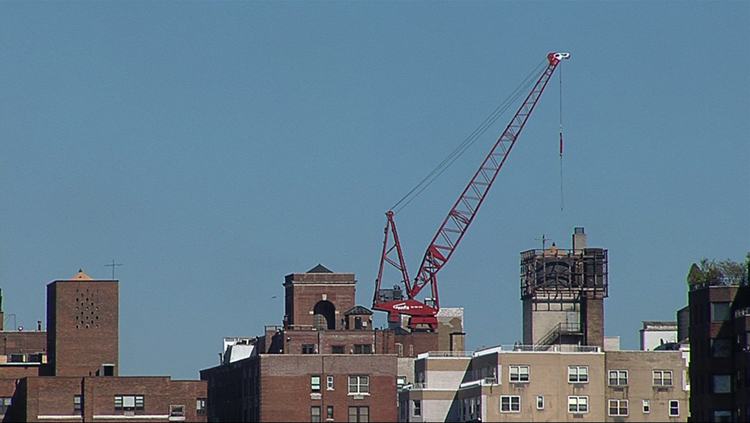 HD100 +10detail
HD100 +10detail
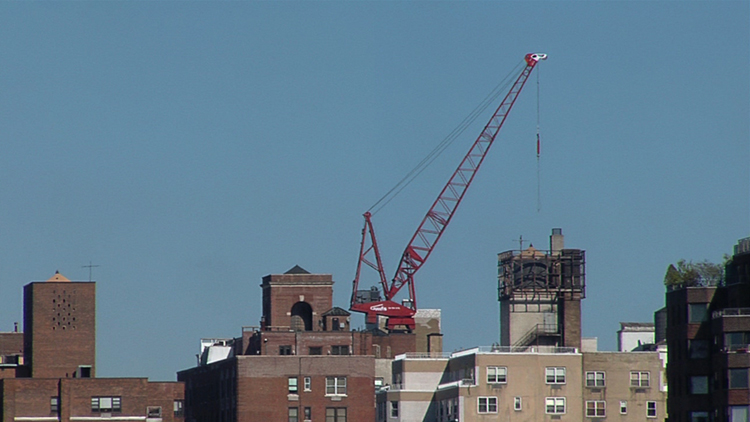 HD100 -10 detail
HD100 -10 detail
I hope this give you a demonstration of two ends of the detail spectrum on both cameras. I did not shut the detail off on the HD100 although it is an option because I can not shut it off on the HVX200. As I see it, the range of usable detail settings on the HVX is less than what the HD100 offers. This might be where pixel shift simply can't make up for a lesser chipset. I think the inherent picture of the HD100 being truly 1280 gives it more range that can't be appreciated comparing it to another camera. I find the HD100 picture more pleasing to my eye. You may see it the other way. Neither is wrong.
And just a word about 1080i. I think it offers little in such a camera as I see it. Here are two shots, one 720 and the other 1080:
 HVX
HVX
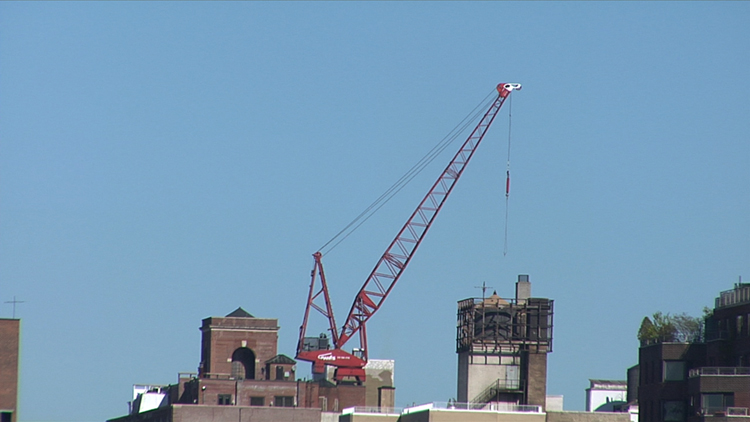 HVX
HVX
Anyone want to guess? First one looks a tiny bit better. Or does it? First is 720 and second 1080. Both are set to max detail setting.
I was curious, I wanted to see what the 1080i of the Panasonic looked like next to the 720p of the JVC. In this shot I cut and past both into a frame. The HVX crane is larger because of how I framed it originally. I did not resize anything.
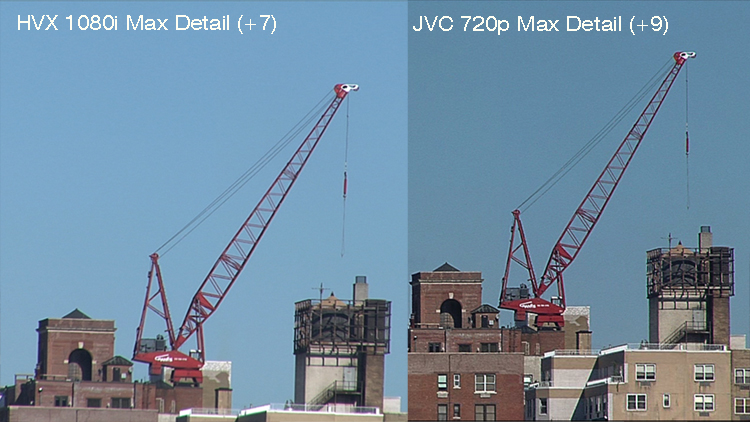
The lenses on the two cameras are quite different in operation. The HVX focuses much closer (MOD) than does the JVCHD100 which needs three feet for focus while the HVX focuses down to a few inches. But the HD100 has a longer zoom. It's stock lens gives you 88mm while the HVX gives you 55mm. Both shots at the end of the focal length are demonstrated below to show you what the extra lens length gives you.
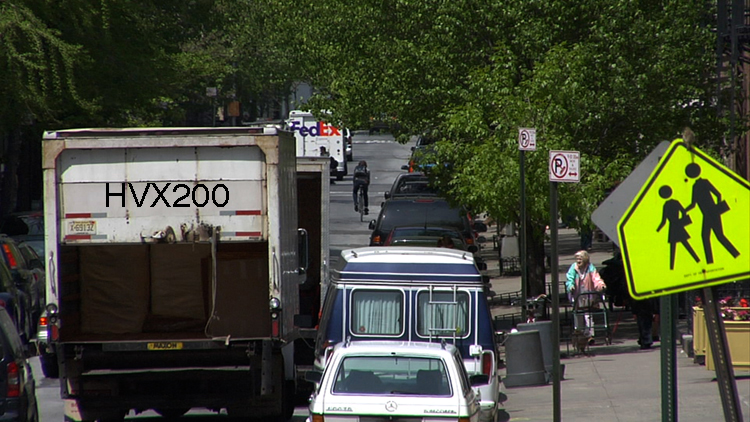
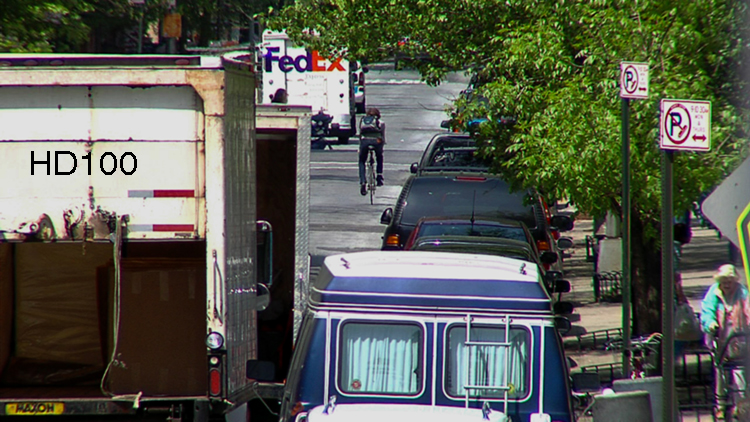
I notice a bit of lens aberrations at the end of the HD100 lens. I can see that in the edges of the No Parking signs in the right side of the picture. In fact in various shooting situations I noticed a variety of lens distortions wide open and fully zoomed in with both cameras. As I said, I don't expect much from the stock lenses of these cameras. They do enough for the purposes of general shooting but I would need a higher quality lens for better reproduction. (Note: Lenses can not be changed on the HVX200). Don't mind the black in the HD100. I altered the blacks for a shot that was before this but not in this article so it looks a bit harsher. This example is about lens length so I didn't reset it.
And finally, let's look at one more photo that will foster a question:
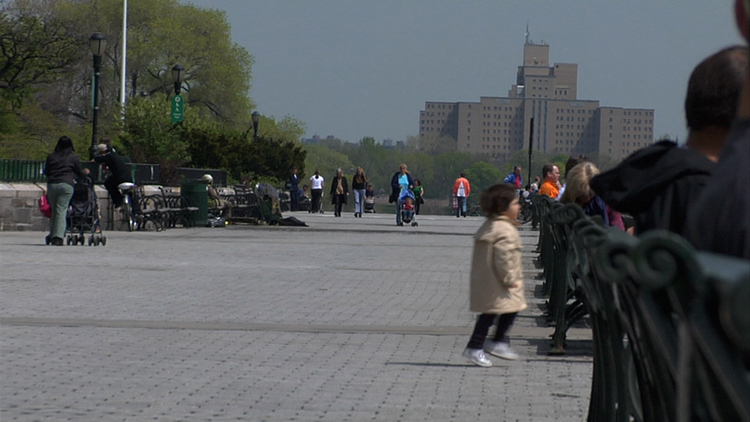 HVX
HVX
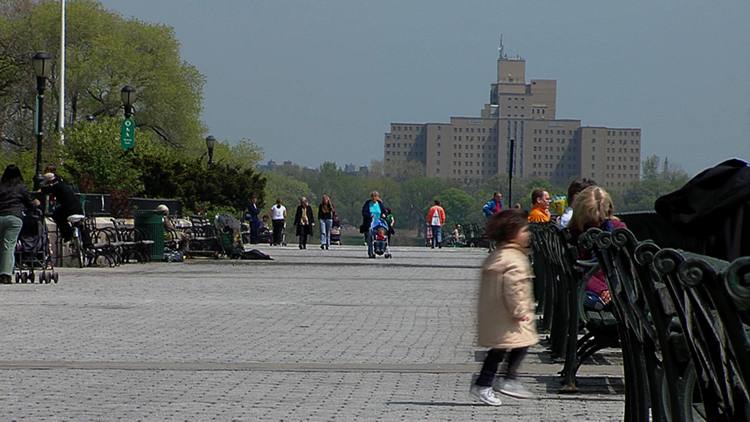 HD100
HD100
Once again I am not surprised that both cameras create a nice representation of the frame. But notice something about the boy running across the frame and how differently HDV handles the motion than the DVC Pro format? The edges of the boys body in the HD00 shot are a bit softer. Of course if this was moving video you would not notice or care, it would simply look like a blurry image of a fast moving boy just as it does in the HVX200 shot. But while we are on the subject of movement, I thought I would investigate just how well HDV handles movement and how it compares to movement with the DVC Pro format.
HDV AND MOVEMENT
So what better way to see movement than with automobile traffic?
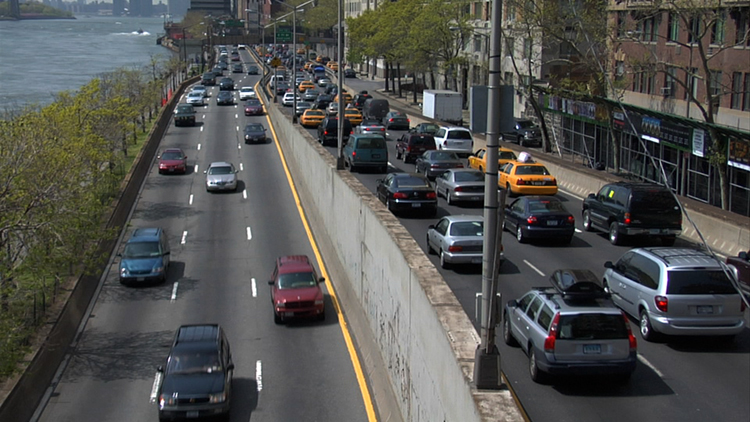 HVX200
HVX200
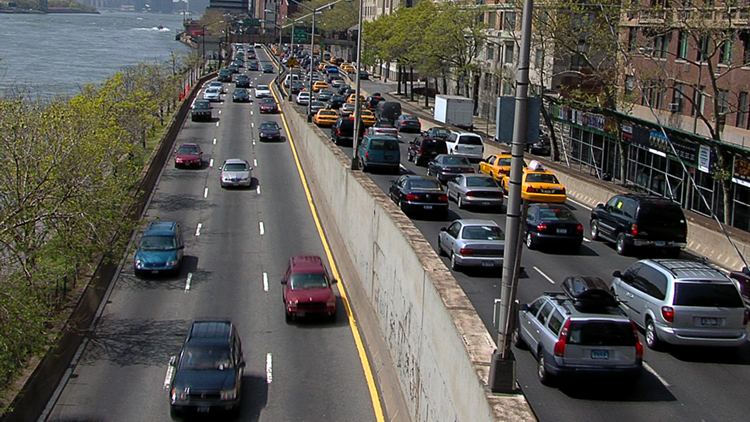 HD100
HD100
We obviously will not be seeing much movement in the downtown traffic on the right so let's look at the uptown traffic on the left for motion. Of course here is a place where still shots can not do it justice. Before we move to actual video, let's establish what it is we are going to look at. I have framed the cameras to see a small portion of the roadway where the autos will pass very quickly.
Take a look at the HVX and movement:
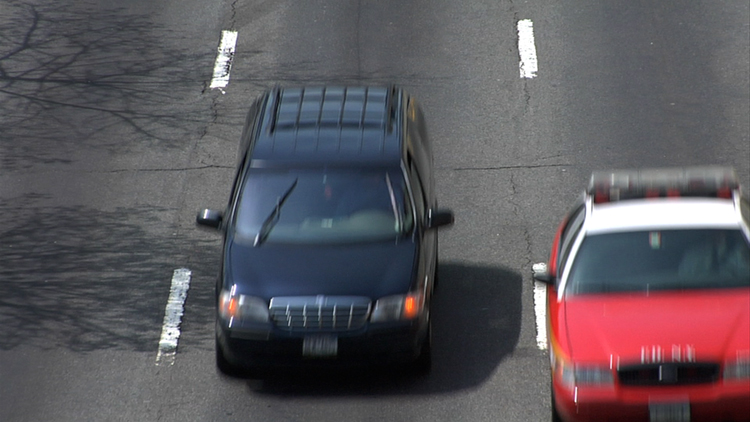 HVX200
HVX200
Notice the blurring of the vehicles moving at a high rate of speed. I would not expect anything but blur in this circumstance. Of course I could have reduced the blurring effect with the use of shutter but in both cameras I am using no shutter. Even so, the FDNY logo on the front hood of the fire vehicle is just visible. Let's see how 6GOP HDV handles the same picture?
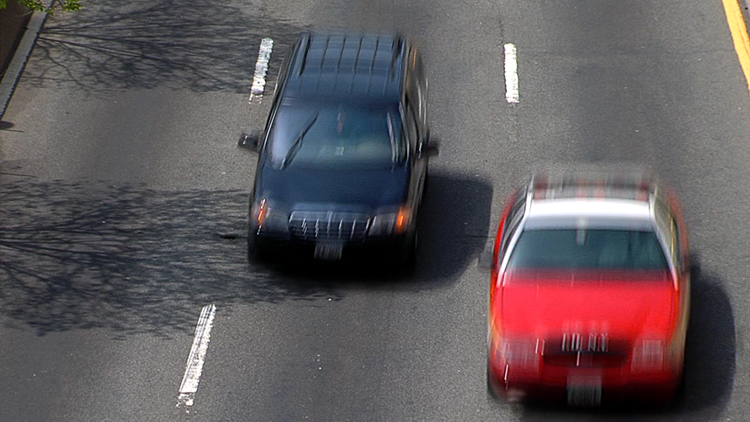 HD100
HD100
The motion in the photo is blurry with both the HVX200 and HD100 as would be expected. But then again, as I said, here is where the important thing is motion not still frames. When you see both videos in motion it looks like blur, and nothing more, nothing different. Download the following clips and play them one after another and tell me what difference you see in the motion if any? I can't see any difference between both cameras playing the video live on a monitor. The bottom line is that both codecs seem to handle the blur of motion the way I would expect other than if you stop the video and stare at a freeze frame, the blur of the HDV codec is not has sharp as the DVC Pro codec which is probably due to the motion smoothing having been turned on the JVC camera. The DVC Pro format has slightly better spatial resolution in this case but they have equal temporal resolution when watching video move. But HDV does handle motion as I would expect any format would with fast motion so that dispels one of the most common myths about HDV that seems to permeate the web.
As I mentioned the JVC camera features something called motion smoothing. JVC describes it as "Makes the video smoother when the tape is played back by adding frames to the signal recorded on the tape during progressive shooting." I used it above but also wanted to see what it did so I shot with it on and off. In the following shots I rolled a model truck by the frame at two speeds, slow and fast. I recorded both with smoothing on and off.
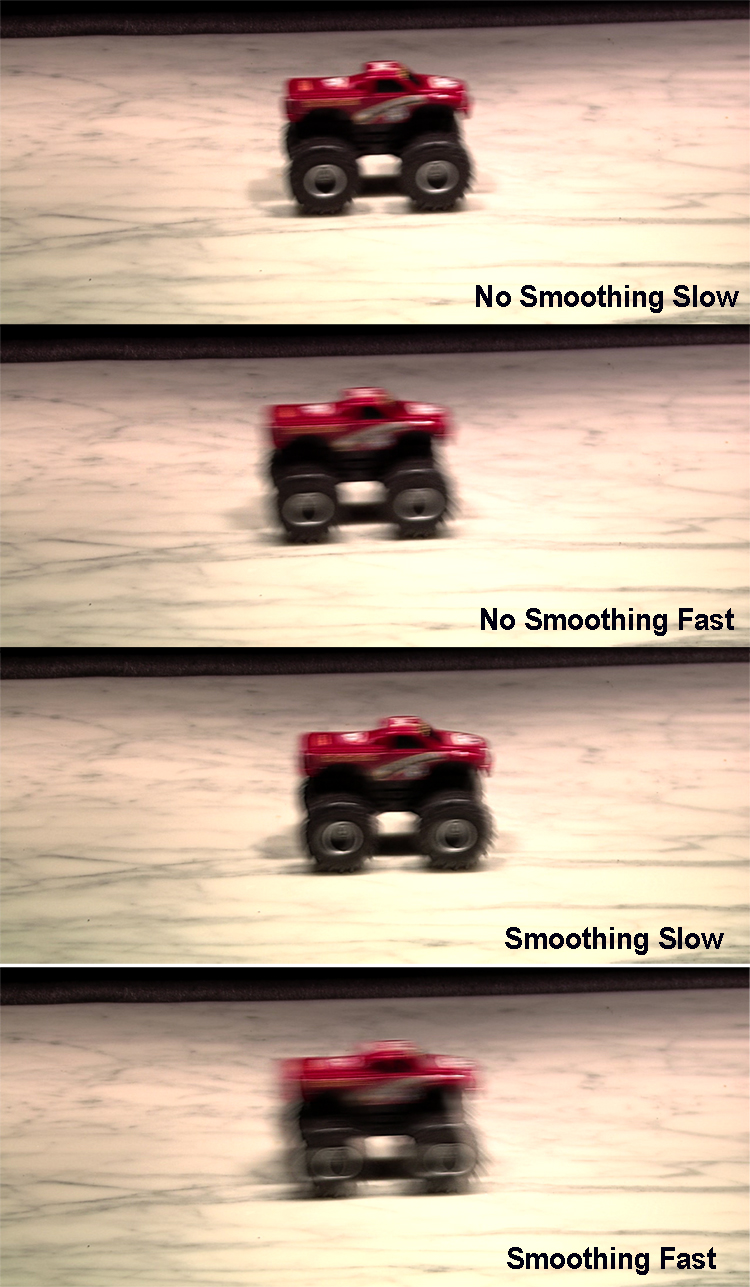
And here is the same photo reduced in size so you can easily get an on-screen view of all four set-ups.
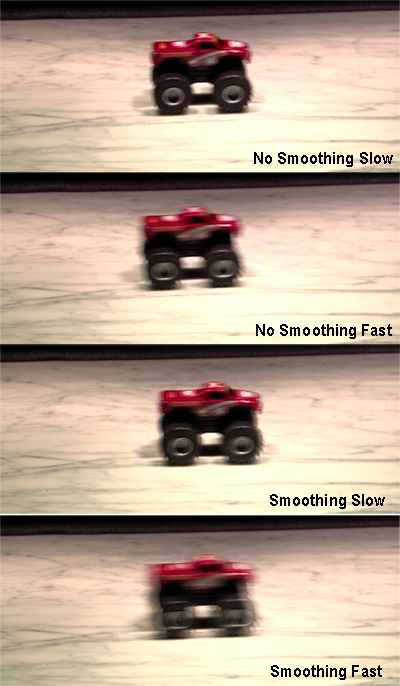
As you can see, with smoothing off the HDV codec handles motion no differently than the DVCPro HD format does. With it turned on there is a distinct double image as frames are added and blended. I think with the new JVC HD200 camera which records a more robust 60P this would not be an issue at all. One would have to test it for confirmation.
CONCLUSIONS
I think between the few examples I showed in this article and the two hours worth of footage I shot during the week, I answered many questions and verified some of the things I have been reading on the web, while disproving others. Both cameras produce a great picture. To my taste the HD100 has a slight advantage in picture quality. That does not necessarily mean 'better'. One of the key advantages I find with the HD100 is ergonomics. After a week of holding the HVX, my wrists hurt the same way carpel tunnel syndrome affects ones wrists. But as I said, I have been used to the kinds of cameras that are shoulder mountable. For someone who is not, it might not mean much that you can only hold the HVX200 out in front of you.
I think the greatest weakness that both cameras share is the monitoring system. Neither cameras flip out screen can approximate the quality of HD. So you never really know if the cameras are in focus based on looking at the screen alone. I found the HVX200's eyepiece made a sharper image than the HD100 but the advantage was negated by the fact that the picture in the eyepiece seems farther away (smaller). The HD100 seems to keep the picture in proper format ratio whereas with the HVX200 I never seemed to get exactly what the screen showed in framing. It was very difficult in matching shots that looked fine when comparing both viewfinders but did not match up on the monitor.
The bottom line is that without the focus assistants on these cameras, it is very difficult to know if you are in focus. I found the focus assistant on the HD100 to be much easier to use than the assistant on the HVX200. They operate in two completely different fashions. On the HVX200, when you press the focus assistant button a smaller screen appears inside your frame (like picture in picture). That screen shows a much zoomed in close up of what you are looking at so you can adjust focus easier. The problem is that it makes using it on the fly difficult as it has a way of making it look like a picture blocking the main picture as if you had picture in picture on a TV and you wanted to watch the main screen but the smaller screen that sits right in the middle of the screen and blocks your vision. Or imagine sitting in a theater and someone head being in the way of most of the screen.
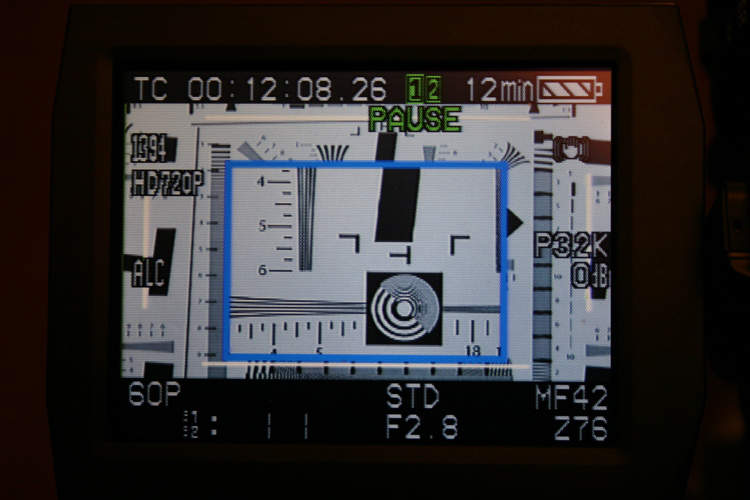
The blue box in the shot above is the Focus Assistant on the HVX200. While it initially helps you focus a shot, it is difficult if not impossible to leave it one all the time while shooting because I always feel like I am missing some action underneath.
The HD100 takes a completely different method in helping make sure you are in focus. It is a method that is much easier to deal with overall. With the HD100 you can pick one of the three color channels (red, blue, or green). When you press the focus assistant button, the screen remains the same but like zebras, the color you picked gets overlaid in areas that are in focus. This makes critical focusing much easier. And you can leave this feature on while shooting without getting vertigo as you might using the HVX200's method of focus assistant.
The blue areas that rim the edges of what is in focus in the shot above show how the HD100 utilizes focus assistant.
If I had to pick one point of each camera that stood out as it's greatest individual weakness I'd say for the HD100 it is the monitoring. It's simply impossible to trust it for focus without some effort. And the monitor does not reproduce as vivid a color picture as you end up with. I guess over time I would get used to it just as I know what colors I get with a black and white viewfinder but it needs a great deal of improvement. For the HVX200 it is the ergonomics. Imagine a DVX100 that someone left in water overnight. When you woke up and took the camera out of the water, like a sponge, it absorbed water and swelled. As a result the HVX200 looks like a fat version of the DVX100. The designers put so many buttons on every inch of the exterior as to make it confusing. Some are user assignable buttons, and others buttons for particular things on the menu, but overall there are just too many buttons to push all over the camera that it gets confusing finding the ones that are important. Perhaps over time I might find this easier. In fact I think over time I would more easily be able to find what I needed and that I only needed certain buttons but then why add them just to add buttons. I guess for some this is a good feature but not for me. I found the menu buttons on the HD100 easier to operate than the HVX200's method. The jog wheel makes it easier to move through menus than the buttons on the HVX200.
The HVX200: Buttons, buttons everywhere!
The HD100 takes a more simpler approach with buttons and more importantly, puts buttons I need in places I need them. For instance the audio controls are directly where I can access them easily as are viewfinder adjustments and white balance controls. On my shoulder everything I need to readily adjust is available. I would probably attribute this to the HVX being an extension of the DVX in design so it has buttons like the DVX, it just seems like more buttons, where the HD100 seems to have been modeled after a larger format camera in the way buttons are placed and what buttons are included.
If I had to pick one strength from each camera I would say with the HD100 it is design. It just feels right. a real lens with real focus, zoom and iris controls can not be beat. For the HVX200 it has to be its compactness. If I needed small HD camera to stick in a place where a big HD does not fit, this camera packs an amazing punch for the size at 14 inches in length.
And if I had to pick one myth from each camera I'd mention the split screen problem that the HD100 supposedly has. As I understand, it was a calibration problem that happened with a few of the first that came out of the factory but between this camera and five other HD100 owners I know, no one has the trouble. And even if you did, if you sent your camera in for the free upgrade I am sure they would have addressed it and calibrated the screen. If you have not done that, nor asked JVC to recalibrate your screen then the problem has become yours, not theirs. With the HVX, the biggest myth is that DVC Pro HD is far superior to HDV I just can't corroborate that statement based on usage. There are certainly a few minor advantages of a frame format like DVC Pro compared to HDV, but not enough to say HDV isn't robust enough for professional work. In fact I can now say from experience that HDV is equal in overall quality to P2 DVCpro HD.
POST WORKFLOW
P2 offers a different way of capturing and in some regards an easier way. The camera keeps control over all the starts and stops and shows you each shot in thumbnails for review or deletion. Indicators in the viewfinder tell you how much time is left although I would like to see it as a seconds indicator and not just minutes left besides the time code readout. One easily forgets that there is no tape in the camera with P2 but is easily reminded once your shorter record times are up. I did not use a laptop to transfer shots as I shot and frankly would find that having to lug around another device would be annoying. I understand there is going to be a HDD by which would be my choice for recording with this camera. It does beg to ask the question, where would I put the device? There really is no place to attach anything to this camera since every corner of it is a button or input device. I guess it would have to go on top or on a belt clip. Transferring P2 to my computer is easy. While it is a bit faster than transferring tape, I think any speed gained in that transfer is lost the same way it is with tape as one has to log the footage anyway. It took 4 minutes and 50 seconds to transfer a full four minute P2 with a single file to my computer using the P2 import on FCP. And I get 4:13 of actual record time on a four minute P2 card so you get a few extra seconds. I do like the delete feature and the format feature because I can easily start from scratch with a few movements through the menus and can kill a bad shot instantly leaving me more time to record. Some additional logging features of the P2 method are useless to me so I did not bother with them. I did not like that the P2 picks random file names for sequential shots when recording. So if I record a shot it calls it 0002FW and the next file I record is called 003RW instead of being called 0002FX. Of course I could label them while shooting but I am not used to that nor inclined to start. P2 is cool method of workflow, but in these smaller cameras where record times are reduced it is not my favorite when compared with inexpensive tape options. Both cameras would do best with a HDD.
There is no denying that P2 is an expensive workflow option and frankly based on these tests, I don't think one that is justified. If it made a difference that was clear, I could see paying more, but I can't. While the DVC Pro HD format is robust, I don't think a 1/3 inch camera can do it justice. I equate it to putting 2 gallons of water in a five gallon bucket. So any advantage to 100 MB DVC Pro recording is not clear from my tests and I must conclude that it is an option that offers nothing more than a cool way to record what appear to be equivalent quality images as HDV. As a result the inexpensive cost of tape is a better option than solid state. I keep hearing that the retail price of P2 will come down, but I just don't see it coming down to a realistic price any time soon. The scariest part of P2 is not knowing if you got something. Out of my days of transferring files, there was one file that would not transfer. I got this message. After some investigation I realized that nothing can be on the firewire connection with the camera and recovered the file. I think most errors I have been reading about on the web are operator error. Only in the professional world of broadcast with the larger P2 cameras have I heard about having a clip that is not readable from P2 by an employee at WWOR TV but even then they tell me it is extremely rare.
Personally, I am not carrying ready to around a laptop to transfer files in the field as is suggested by some. The idea behind a smaller camera is mobility, not more equipment. Perhaps in a studio scenario, but I would more than likely not use these small from cameras in a studio scenario. Once again the best option would be a firestore HDD (or one of the other HDD companies) for both cameras. I understand that it is integrated more with the JVC camera through better functionality than with the HVX200. I am told that means in-camera viewfinder display of the HDD condition, including remaining capacity, operating status, etc. More recording options: Tape/HDD simultaneous record; Tape/HDD series record and Tape/HDD split record. In fact as I understand it, the recent upgrade to the JVC camera had a lot to do with this functionality. I understand the Panasonic does not have this functionality but if anyone knows of equivalent functionality with the Panasonic camera, let me know so I can add to or correct this statement. EIther way I'd take a HDD drive option with the HVX200 over P2 in a heartbeat. The tape recording of HDV with the JVC100 makes it more convenient than P2 with a HDD option offering even more.
When looking at tape vs solid state, the HD100 offers the same method of tape workflow that I have used for years so it is nothing new or different. I used a method that captured my footage outside of FCP. I did not capture footage as HDV although I could have. Rather I choose to wrap it as a different file type. This adds some time but the result is worth it as it allows me to edit the footage as something other than HDV. There is a bit of lag time when playing or searching through a tape on a HDV machine but other than that, it is no different than any other tape method with DV. I would have liked to see LED indicators on the switches to tell me what I am doing. I am also used to the ease of the play stop and rewind buttons with tape so that is comforting. With P2 is it similar in playing a clip but you have to select a file highlight it and then press the play button. It is a bit confusing going back and forth between clips but not something I would not get used to with over time and of course easier to jump around a shoot sequence. Overall, I do not like where the deck buttons are placed on the JVC deck. They are small and not easy to deal with. And the earpiece that comes with it (like a single muff of headphones) is nice but useless. It gets in the way of using the deck controls and I removed it. A small piezo speaker would have sufficed like the HVX has.
Overall both cameras performed well. It has become clear to me that the JVC camera makes a more robust picture. Even at 1080i with the highest detail setting the HVX isn't up to par with the 720p of the JVC camera. After you read this article click here to see detailed test results done at the BBC which confirm my findings related to the HVX200; that the camera does not produce a full 1080 line picture, that accurately measuring frequency response with the camera is difficult, and that due to design limitations using a SD chip that uses pixel shift, the camera has limited detail settings that are very much unusable. Also note the authors claim that many of the menu controls have little or no effect on picture quality. I noticed that many of the controls in my test did nothing to change picture quality but didn't mention it because I though I was doing something wrong. I guess I wasn't.
I think that these cameras serve two different purposes and have different appeals depending on who uses them so to do a one-on-one comparison that suits everyone is difficult. No test is perfect and no situation perfect. You'd have to pick both for yourself up to determine what works best for your needs. For someone such as myself who has used large professional cameras that all have a certain design and feel all my life, the JVC HD100 is a better choice. For someone that is a videographer perhaps the smaller HVX200 would suit him better. None is wrong. I think folks have got to stop looking for better or worse, when in many cases it's what works for you that is more important since the better or worse is really slim with many of these cameras. Some folks like ketchup on eggs. Some do not. Eggs are not better with ketchup. Well they are for some people, but it is not wrong, just different. There is a reason why there are so many choices, because there are enough tastes. A restaurant menu has choices and some folks like one thing and others another. You must look at a camera for how it works for your needs, not because a manufacture markets it as the greatest thing since sliced bread or some web site you hang out on has folks who all own one camera and rave about it. Of course they rave, they own the camera! Here is a great way to decide on a camera. Step back and make a list of things you like and things you dislike about a camera. If after a while if your 'dislike' column has no entries or just a couple, then you haven't really evaluated the camera properly. All cameras have things you should dislike or wish for improvement from and only testing can tell you that, not looking at it in a store mounted on a tripod with a security tag attached to it.
Copyright 2013 by Walter Graff. This article may be circulated and shared as long as the following reference is made: 'This article appears courtesy of Walter Graff- http://www.waltergraff.com'
Please don't hesitate to send me an e-mail if you have any questions or comments please e-mail me at Walter@waltergraff.com
Addendum
4/27/06 I am adding to this article as people ask me questions so please feel free to ask so I can show you with examples
4/28/06 I have received over 300 emails in the last 12 hours thanking me for writing such an extensive article. It was a lot of work and is still not finished but I wanted to say thanks for all the kind emails. This is how I believe equipment should be tested, not the way many publications do often giving you back what is written in the equipments brochure.
4/29/06 I saw this on a web site today: " It was quite a thorough comparison and I agree with his conclusions, I only wish he had compared the motion signature with the motion smoothing turned off. " Walter's note- I added that portion of my test to the article.
4/30/06 Text softened to a grayer white at the request of a reader
4/30/2006 I corrected an error I made in calling minimum detail in the HD100 -9. The detail on the HD100 goes from min to max like this: min -1, -2, -3, -4, -5, -6, -7, -8, -9, normal, 1, 2, 3, 4, 5, 6, 7, 8, 9, Max. I mistakenly called minimum detail -9 when it is not, so I am calling it -10 which i s what min would be in numeric terms to correspond with the HVX that only has number to represent detail levels. Remember that -7 on the HD100 and -7 on the HVX200 do not correspond to any standard since different manufactures detail numbers are not one-to-one. The HD100 has an option to turn detail off completely. I choose not to do that for this demo since I can not completely turn off the detail on the HVX200.
6/22/2006 I added some comments in response to a statement made by a representative who works for Panasonic.
